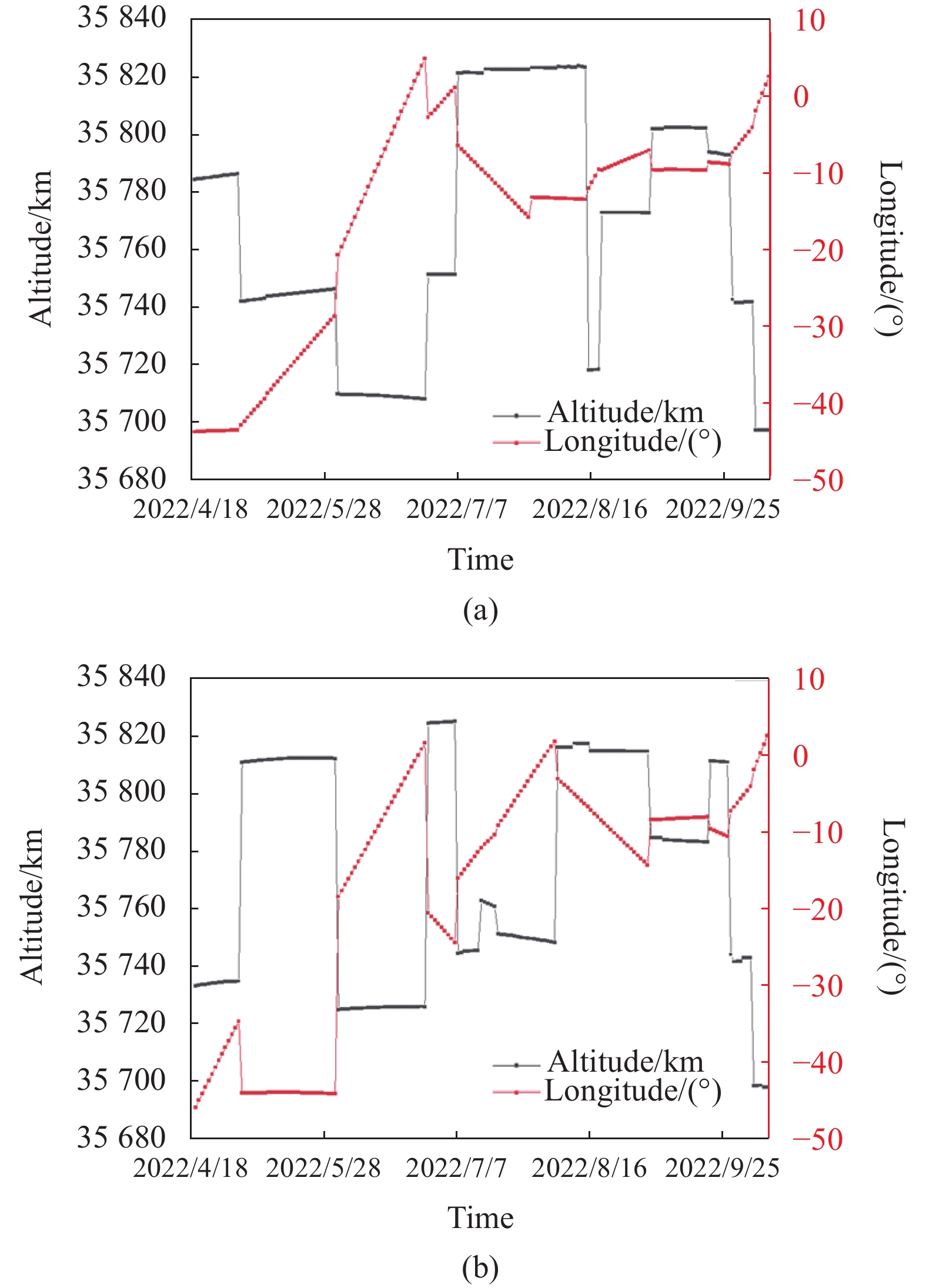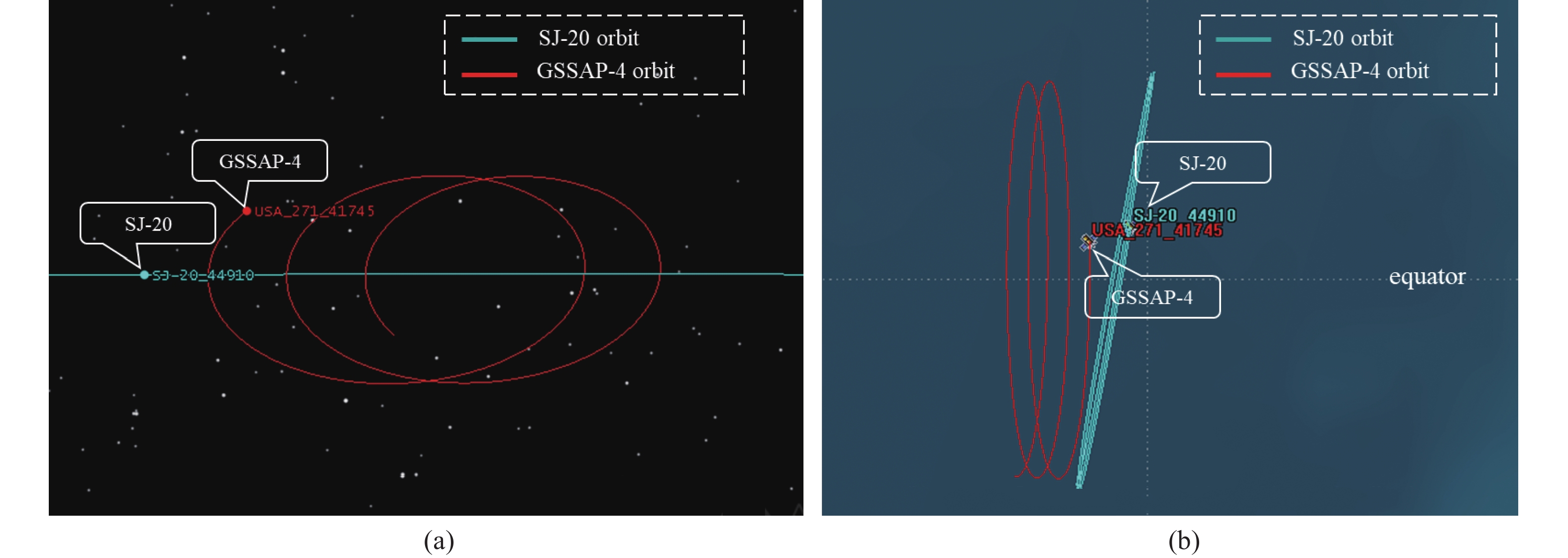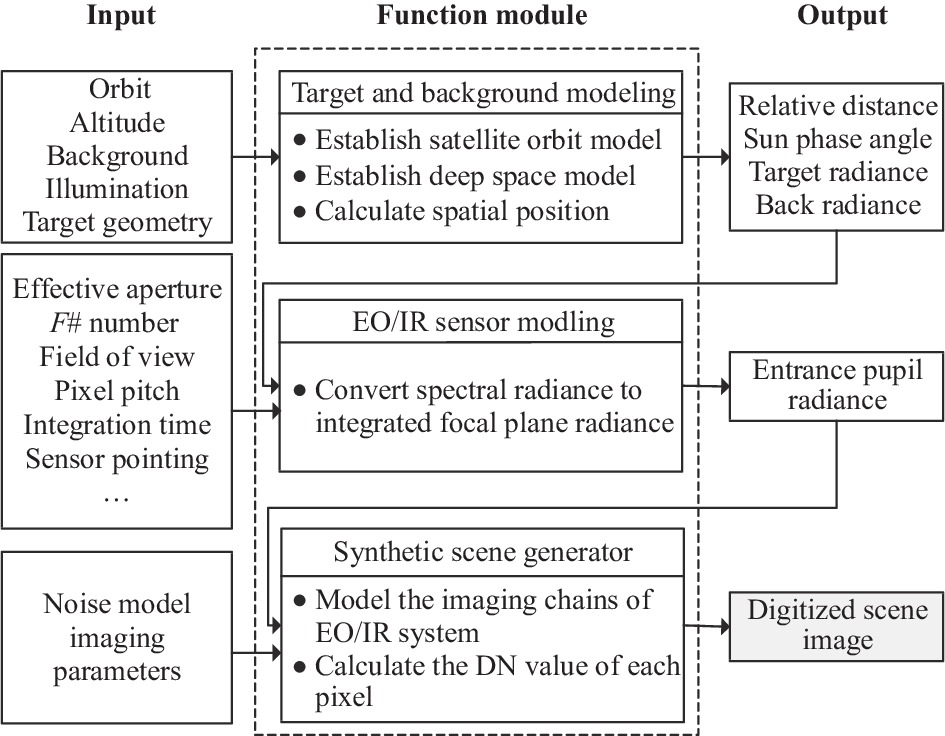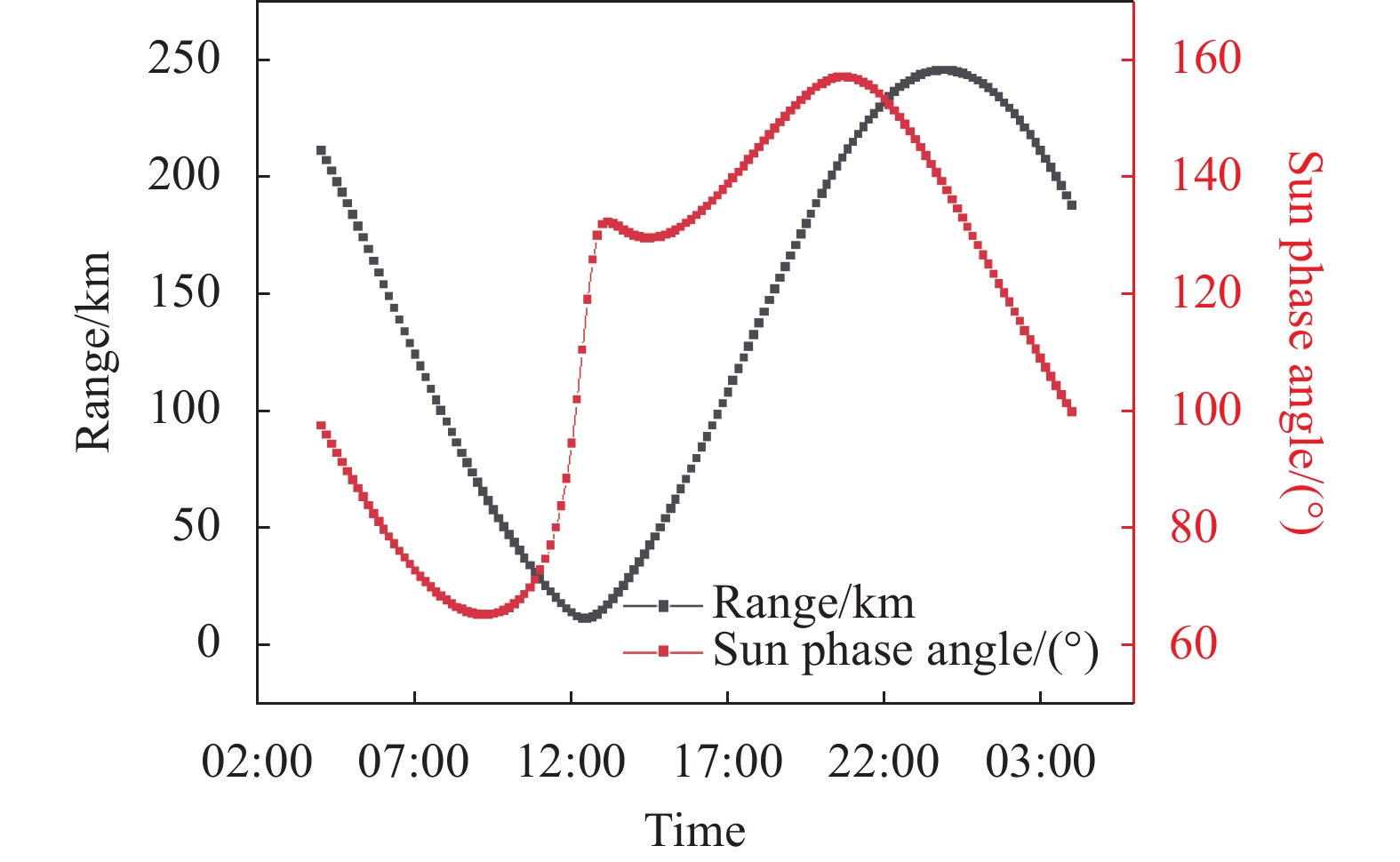-
地球同步轨道(Geosynchronous Orbit, GEO)是太空中的战略要地,运行着通信卫星、数据中继卫星、电子侦察卫星、导弹预警卫星以及气象卫星,高价值目标的密集分布使得高轨成为了太空战场的“马六甲海峡”[1]。随着航天任务范围的不断扩大,对高轨卫星的应用朝着天基态势感知[2]、非合作目标特性获取[3]、在轨操控控制[4]、交会与接近[5]等新型航天任务扩展,GEO区域逐渐成为各国关注的焦点,相关技术也成为国际竞争的前沿。
为控制该战略要地、确保自身太空优势,美军在其军事战略、先进技术和财力支持下,部署了大量空间攻防装备[6]。2006年6月美国以一箭双星的方式发射了卫星技术试验卫星(MiTEx)[7],运行在准地球同步轨道,进行GEO目标近距离成像技术验证。在MiTEx卫星技术基础上,美国空军提出了“地球同步轨道空间态势感知计划”(Geosynchronous Space Situational Awareness Program,简称GSSAP),通过对高价值目标的严密跟踪与监视,掌握每颗卫星的任务功能、构型配置、性能指标、活动规律等信息,并了解意图、过程和效果,以强化太空态势的单向透明优势[8]。
纵观公开文献,国内学者从多个方面对GSSAP卫星进行了研究分析,刁华飞等人[9]首次归纳总结了GSSAP卫星的平台情况、轨道情况及卫星的任务操控,并仿真分析了观测距离、观测角度对其成像能力的影响;宋瑞等人[10]通过对GSSAP系列卫星的能力进行分析,总结出高轨巡视卫星的能力现状和规律性行为;肖余之等人[11]结合高轨目标的轨道特性和光照特性,开展了高轨目标顺光成像的机动控制、告警相机视场精准配置、目标三维重建以及实践情况等研究;王典军等人[12]基于GSSAP的历史轨道数据和典型观测事件,分析并研判了GSSAP卫星的总体设计和在轨运行模式,提炼出漂移巡视、机动巡视和抵近等在轨运行策略,并通过仿真分析比较了不同工况下的效能。上述学者在GSSAP卫星总体设计、工作模式、轨道特性等方面的研究取得了一定的进展,有效促进了我国天基空间态势感知技术的发展。但针对GSSAP历史轨道数据所蕴含的情报信息挖掘力度不够,缺乏GSSAP卫星在轨应用的深度分析,对GSSAP成像能力的研究较为粗浅,没有结合实际星历数据深入分析。
文中对GSSAP卫星的发展历程、平台情况、轨道特性、任务操控、总体指标进行了研判分析,深入研究了卫星的历史星历数据,分析并统计了潜在的在轨应用案例;开展了卫星在抵近目标过程中的动态光学成像仿真实验,模拟了不同观测距离、不同太阳相位角对成像效果的影响,相关研究对开展高轨卫星平台威胁自主感知、主被动自卫防护、空间博弈对抗、在轨维护与监视等任务具有重要的价值和意义。
-
GSSAP (见图1)是美国空军最新的空间态势感知卫星,具备GEO轨道持续监视和抵近详查能力,星上搭载高分辨率光学相机和高性能电子侦察设备,可对目标进行“拍照”和“窃听”,图像分辨率达到厘米级,可看清目标天线、传感器等细节信息;同时也能够窃听目标发射的无线电信号,用于目标卫星身份识别和行为活动判断的指标。
据公开资料显示,目前已经部署6颗GSSAP卫星(见表1),运行在GEO±50 km附近,通过双星/多星的组网运行,具备网络化、体系化的协同作战能力,使美国高轨空间目标的探测和识别能力得到进一步提升。GSSAP-1/2于2014年7月28日发射,2015年9月具备初始作战能力;GSSAP-3/4于2016年8月19日发射,2017年9月具备初始作战能力;GSSAP-5/6于2022年1月21日发射,比原计划推迟两年,推测在技术上进行了重大升级改进,尤其是对成像探测系统的改进,解决了传统光学成像对逆光目标无法有效探测的能力缺陷,同时基于新技术体制实现了有效载荷的轻小型工程化。
Satellite COSPAR ID Name Launch date Platform Carrier rocket Current orbit parameters GSSAP-1 2014-043 A USA 253 2014.07.28 GEOStar-1 Delta-4 M+(4,2) 36826 km×36775 km, 2.026° GSSAP-2 2014-043 B USA 254 2014.07.28 GEOStar-1 Delta-4 M+(4,2) 36116 km×36107 km, 1.322° GSSAP-3 2016-052 A USA 270 2016.08.19 GEOStar-1 Delta-4 M+(4,2)(upg.) 35768 km×35762 km, 0.848° GSSAP-4 2016-052 B USA 271 2016.08.19 GEOStar-1 Delta-4 M+(4,2)(upg.) 35748 km×35742 km, 0.817° GSSAP-5 2022-006 A USA 324 2022.01.21 - Atlas-5 35703 km×35697 km, 0.167° GSSAP-6 2022-006 B USA 325 2022.01.21 - Atlas-5 35704 km×35698 km, 0.343° Table 1. GSSAP satellites basic information
GSSAP卫星获取的目标图像、无线电信号通过美国太空部队卫星控制网(Space Force Satellite Control Network,SFSCN)的地面站传输,数据发送到位于科罗拉多州施里弗空间部队基地的第9太空三角洲部队(Space Delta 9)的第1太空作战中队。据美国军事与航空电子网站2020年3月27日报道,美太空军第1太空作战中队已经完成GSSAP地面系统的大规模升级,升级后的系统于2019年12月完成试验,2020年2月12日通过作战验收。
截止到2022年10月8日,根据美国空军第18太空控制中队对外公布的数据显示,GSSAP-1轨道半长轴43179 km (GEO+1015 km),倾角2.026°;GSSAP-2轨道半长轴42490 km (GEO+326 km),倾角1.322°;GSSAP-3轨道半长轴42143 km (GEO-21 km),倾角0.848°;GSSAP-4轨道半长轴42124 km (GEO-40 km),倾角0.817°;GSSAP-5轨道半长轴42078 km (GEO-86 km),倾角0.167°;GSSAP-6轨道半长轴42079 km (GEO-85 km),倾角0.343°。
-
GSSAP卫星通常运行于近地球同步轨道(GEO±50 km,GEO=35793 km),形成相对GEO轨道向西漂移或向东漂移的巡视模式。经调研得知,GSSAP-1早期执行全球巡视详查,目前已进入坟墓轨道,GSSAP-2早期执行120°E~0°W的区域巡视,目前全球区域漂移[12]。
图2(a)所示为GSSAP-1近3年的轨道高度和星下点经度变化情况,经分析得出,此期间主要执行东半球GEO轨道巡视,并极有可能于2021年2月1日进入坟墓轨道。图2(b)所示为GSSAP-2近三年的轨道高度和星下点经度变化情况,经分析得出该期间主要执行整个GEO轨道的巡视。
图3(a)所示为GSSAP-3近3年的轨道高度和星下点经度变化情况,此期间轨道变化频繁,大部分时间运行在GEO±50 km轨道上,但也出现GEO±150 km的情况,主要负责执行0°E~100°E巡视任务。图3(b)所示为GSSAP-4近三年的轨道高度和星下点经度变化情况,主要运行在GEO±50 km,主要负责执行50°E~180°E巡视任务。
2022年4月19日,美军才正式对外公布GSSAP-5/6的星历数据。从图4(a)所示的GSSAP-5轨道变化情况可知,初始轨道高度保持在35785 km,从5月2日开始降低轨道高度,到6月底时降到35708 km;此后逐渐抬升轨道,至8月中旬升至GEO上方30 km处;8月下旬开始降低轨道高度,经过1个月的轨道漂移,最终定轨在35697 km;巡视范围为43°W~2.6°E,大多数时间以每天0.5°~1.2°的速度由西向东漂移。从图4(b)所示的GSSAP-6轨道变化情况可知,初始轨道高度保持在35733 km,5月2号开始抬升轨道,整个5月份一直保持35812 km;6月份轨道高度一直保持在35725 km,此后7、8月份经过多次轨道调整,最终定轨在35697 km;巡视范围为46°W~2.7°E,大多数时间以每天0.4°~1.1°的速度由西向东漂移。
-
参考文献[12]对GSSAP卫星的主要战技指标进行了综合研判,文中结合相关资料[13]给出了一些结论性数据。单颗GSSAP卫星的质量约为650~700 kg,本体几何尺寸约为1 m×1 m左右;供电系统由2个可展开的太阳电池翼构成,面积约为6 m2,有效功率为200 W (可扩展至1500 W);卫星平台为GEOStar-1,设计寿命5~8年,有效载荷150 kg,主推进系统采用双组元主发动机,具有310 s的比冲,可提供高达1000 m/s的速度增量,使卫星能够在任务过程中完成多种类型的轨道机动,轨道微调和定点保持机动则采用单组元推进模式;外形为一体结构,光学相机未安装转台,对目标跟踪均采用平台机动;卫星姿态确定由星敏感器和陀螺仪完成,指向精度优于0.4 mrad;姿态控制采用高扭矩反作用轮,姿态机动速度为1.0 (°)/s;轨道确定和授时基于GPS实现,定位精度为50 m。
-
GSSAP卫星对目标的抵近观测模式有两种,即绕飞和掠飞。绕飞模式适用于共面目标,掠飞模式适用于异面目标[14]。共面交会问题中,两个航天器运行轨道的倾角小于0.05°;在异面交会问题中,两个航天器运行轨道的倾角大于或等于0.05°[15]。
GSSAP卫星对目标绕飞的轨迹为椭圆,东西方向(前后方向)为长半轴,上下方向为短半轴,长半轴与短半轴的比例约为2∶1,如图5(a)所示。在掠飞观测模式下,GSSAP卫星的轨道一般在目标下方30~50 km处,利用轨道漂移实现对目标的成像侦察,如图6所示。
-
根据俄罗斯科学院ISON空间监测网络数据显示,GSSAP卫星自具备作战能力以来执行了数百次机动,并以10~15 km的距离完成了对俄罗斯、中国、巴基斯坦等国多颗卫星的抵近侦察[16],表2统计了部分抵近事件。
GSSAP卫星频繁的抵近行为对我国高价值空间资产的安全造成了严重威胁;同时,美军系列空间攻防技术试验,揭示了其阻断我国应用空间的能力和目标。笔者利用卫星两行轨道数据(TLE)对其工作模式、在轨活动进行了深入研究分析。选取GSSAP-1~4在2020~2021期间的TLE数据,其中GSSAP-1有198行、GSSAP-2有246行、GSSAP-3有124行、GSSAP-4有86行;同时获取我国在轨大部分GEO卫星在相同时间段内的TLE数据,利用轨道分析工具计算出GSSPA和目标卫星之间的距离,以1000 km左右为抵近判定的依据,得到潜在的数十次的抵近事件,被抵近的目标有北斗导航系列、通信试验系列、实践系列等GEO卫星,最近距离达到了9.54 km(实践-20),详细信息如表3所示。
Date Satellite approached Country Range/km 2016-09-13 TJS-1 China 15 2017-07-13 Express AM-8 Russia 10 2017-09-14 Luch Russia 10 2017-09-21 Paksat 1 R Pakistan 12 2017-09-29 Nigcomsat 1 R Nigeria 11 2017-10-05 Blagovest Russia 14 2017-11-17 Raduga-1 M 3 Russia 12 2018-05-14 Raduga-1 M 2 Russia 13 2020-08-23 SJ-20/Chinasat 6 A China 24 2022-01 SJ-12 01,SJ-12 02 China 73 Table 2. Satellites being closely scouted by GSSAP
通常以太阳相位角[17]来描述目标、观察者、太阳的几何关系,即GSSAP-太阳连线与GSSAP-目标连线的夹角,不同相位角条件下,目标的亮度信息变化较大。通过对表3中列出的数十次抵近事件分析,得出了GSSAP抵近过程中的太阳相位角的变化情况,如图7所示,即GSSAP抵近时的太阳相位角一般保持在40°~160°之间,此时目标位于GSSAP的顺光观测区,可有效规避太阳杂散光对成像的影响;而GSSAP位于目标的逆光区,导致无法精确、实时的探测到空间抵近威胁。
Date GSSAP Satellite approached COSPAR ID Range/km Longitude Mode 2020-02-26 GSSAP-1 TIANLIAN_2-01 2019-017 A 88.40 79.786°E Fly-around 2020-02-28 GSSAP-1 BD-2_G8 2019-027 A 109.97 79.786°W Fly-around 2020-04-8 GSSAP-4 SJ-13 2017-018 A 360.13 110.846°E Fly-around 2020-11-01 GSSAP-4 SJ-20 2019-097 A 11.60 124.940°E Fly-around 2020-11-23 GSSAP-4 SJ-13 2017-018 A 101.94 110.605°E Fly-by 2020-11-30 GSSAP-4 TJS-2 2017-001 A 53.38 107.448°E Fly-by 2021-01-01 GSSAP-3 TJS-3 AKM 2018-110 C 469.62 59.621°E Fly-around 2021-03-19 GSSAP-4 TJS-2 2017-001 A 28.37 107.435°E Fly-by 2021-04-16 GSSAP-3 TJS-3 2018-110 A 1141.25 86.098°E Fly-around 2021-05-03 GSSAP-3 SJ-20 2019-097 A 1032.06 86.090°E Fly-around 2021-05-04 GSSAP-4 SJ-20 2019-097 A 9.54 87.421°E Fly-around 2021-05-06 GSSAP-4 TJS-3 2018-110 A 104.29 87.641°E Fly-around 2021-09-30 GSSAP-4 SJ-20 2019-097 A 54.71 87.576°E Fly-by 2021-12-02 GSSAP-4 TJS-5 2020-002 A 56.70 107.546°E Fly-by Table 3. China GEO satellites being approached by GSSAP
-
空间光学遥感器的成像仿真是个复杂的系统工程,需要对各个环节进行精细建模,模型的精度直接影响最终仿真结果的真实性和可信度。GSSAP的成像仿真过程可以分为三个步骤:目标与背景建模、光电传感器建模、场景成像模块。GSSAP成像仿真的每个步骤之间的输入、输出和数据流关系如图8所示。
据Breaking Defense网站披露,GSSAP-4于2021年8月下旬对中国目前最大、最重的通信卫星-实践-20实施了抵近伴飞[18]。因此选取GSSAP-4抵近实践-20的场景为例,分析抵近过程中时成像效果。通过分析TLE数据得出,GSSAP与实践-20星的最近距离达到9.54 km,并处于有利的太阳相位角,达到了顺光成像观测目的。GSSAP-4与实践-20的相对距离和太阳相位角变化趋势如图9所示。
-
笔者结合了卫星平台的总体情况、载荷的质量约束、在轨典型的作战模式等信息研判,推测出其光电成像有效载荷的口径为500 mm,F#为10,像素规模为1024 pixel×1024 pixel,像元间距为6.5 μm,探测谱段为450~680 nm,积分时间为20 ms,GSSAP的有效载荷详细参数如表4所示。
Parameters Values Effective aperture/mm 500 F# 10 Field of view/(°) 0.076×0.076 Pixel pitch/μm 6.5 Integration time/ms 20 Spectral wavelength/nm 450-680 Number of pixels/pixel 1024×1024 Instantaneous field of view/(″) 0.268 Dynamic range 3000 Reference noise equivalent iradiance/W·cm−2·sr−1 1.0×e-15 Reference saturation equivalent iradiance/W·cm−2·sr−1 3.0×e-12 Table 4. GSSAP payload parameters
-
GSSAP-4在对实践-20卫星抵近成像的过程中充分利用了顺光成像的优势,借助轨道绕飞实现了对目标卫星多角度的精细成像。图10和图11展示了GSSAP抵近和离开实践-20的成像效果,该过程中GSSAP与目标之间的距离变化为133.18 km→10.17 km→119.07 km,太阳相位角保持在134.37°~44.67°,随着观测距离的减小和太阳相位角的变化,探测器的成像效果也越来越好。当距离到达50 km时,可获悉观测目标的大致结构,当距离达到20 km时,能够看到观测目标的具体细节。根据参考文献[19]中的探测器像元分辨率计算公式得知,在距离观测目标10 km时,GSSAP相机像元的空间分辨率为1.3 cm,此时可对观测目标进行高分辨率的精细成像,从而发现目标本体、太阳帆板、有效载荷等更多细节信息。由此,可以判断GSSAP卫星对目标的探测距离约为100 km左右,抵近详查的观测距离在10 km左右。此外,在不同的太阳相位角下,相机受太阳杂散光影响,GSSAP对目标成像效果差别较大,因此在高轨观测时需要综合考虑太阳光照和观测角度问题,选择合适的位置才能获得较好的成像结果。
-
文中针对GSSAP卫星的总体设计、轨道特性、观测模式进行了分析研判,对GSSAP的历史星历数据进行了深入研究,挖掘出其对我国高轨GEO卫星的潜在抵近侦察事件,并对某次抵近过程进行了成像仿真分析。下一步需重点考虑相机有效口径、探测器积分时间、像元间距、噪声在一定范围内变化时,对成像效果以及探测能力的影响。针对高轨严峻的空间安全竞争态势,迫切需要研究和突破高精度交会与接近、近实时轨道异动感知、复杂光照条件下目标特性获取、多手段主动被防护等关键技术,以加强高轨空间高价值资产的自保护能力;此外,还需加快推进天地一体、分布式的态势感知网络建设,发展全维空间态势感知能力,实现对GEO目标的全天时、全天候的监视,确保太空环境安全和航天器运行安全。文中相关工作可为空间目标光学探测与识别、星载平台自主感知与对抗提供理论依据与数据支持,具有重要的工程应用价值。
On-orbit application research and imaging simulation analysis of GSSAP satellite
doi: 10.3788/IRLA20220759
- Received Date: 2023-02-15
- Rev Recd Date: 2023-03-25
- Available Online: 2023-04-14
- Publish Date: 2023-04-25
-
Key words:
- geosynchronous situational awareness /
- GSSAP satellite /
- close-in observation /
- fly-around imaging /
- fly-by imaging /
- solar phase angle
Abstract:





















 DownLoad:
DownLoad:









